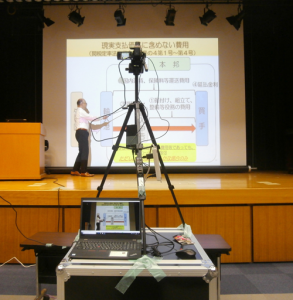Japan Customs conducts online induction training for new recruits
17 June 2020
By Japan CustomsAs more countries imposed restrictions on movements and gatherings to fight the spread of COVID-19, online training that might have been a useful tool before, suddenly became a necessity. In this article, Japan Customs explains how it quickly adapted to the situation to keep offering new recruits the training they needed to take on their first assignment with confidence.
Japan Customs has three main missions: protecting society; collecting duties and taxes appropriately and in a fair manner; and further facilitating legitimate trade and travel. These missions are intertwined, and are getting more complex. This complexity, as well as the key and various functions Customs plays, from ensuring proper clearance of increasing in-bound passengers to countering terrorism, has been recognized, including at the political level. As a result, the administration has been given additional human resources, and the number of newly recruited Customs officials has been increasing in recent years.
The Japan Customs Training Institute (CTI) provides various kinds of training programmes, which are designed according to officers’ skills and career paths. Among these various training programmes, the one developed for newly recruited officers is of particular importance. It is indeed imperative for new recruits to understand the laws and regulations they will have to enforce, the powers that are granted to them to do so, and the working techniques they will have to implement.
The training consists of academic classes presented by experts in their field, as well as a practicum provided by experienced CTI trainers. After attending the courses, recruits are then sent for practical courses, so-called on-the-job training, which is delivered at their respective workplaces.

Thinking outside of the box
With the latest induction training planned for April 2020, when the country was still applying strict measures to stop the spread of COVID-19, the CTI had to quickly alter its way of training, moving away from the conventional classroom format. Following the government’s “stay at home” guidance, theoretical courses, which were deemed fundamental, were recorded to enable new recruits to follow them online.
The topics deemed essential included the National Public Service Act, Tax Laws, Customs Laws, and operational procedures related to basic Customs procedures such as Customs clearance, surveillance and control, commodity classification, and rules of origin.
Regarding on-the-job training, it was maintained, but recruits were divided into smaller groups.
This is the first time that the CTI has had to conduct home-based online induction training, which required various detailed arrangements to be taken as well as coordination with the Customs and Tariff Bureau (CTB) of the Ministry of Finance and the respective regional Customs offices.
The home-based online training was arranged in the following manner:
- The CTI prepared a detailed handbook, detailing how to login to the online platform and providing the training schedule and security instructions, that was distributed to all trainees.
- A syllabus and textbooks were distributed ahead of each lecture, in order to allow officers to prepare and duly understand the aims and purpose of the courses.
- Notices and additional information, such as changes to the schedule, were properly communicated.
- Lecturers were asked to stay available to students to answer questions, and their contact details were shared with students.
- Lecturers developed short tests for each student to take at the end of each lecture in order to validate their acquisition of knowledge, and wrap-up examinations were conducted once the student had gone through the entire series of recorded lectures.
- The CTI monitored the work done by each trainee through the system, and any delay or absence was investigated.
- Trainees were required to submit a daily activity report through the system, and could pose questions to the lecturers by email at any given time.
Challenges encountered
The CTI has encountered some challenges in the course of arranging home-based online training. For example, while almost all trainees had a smartphone, they did not necessarily all have a PC or tablet, tools that are the most appropriate for online training purposes. To overcome this challenge, the CTI had to try out the course on several smartphones, browsers and operating systems.
In addition, the files of the recorded lectures were rather heavy. Although the CTI managed to reduce the size of the files, the data transmission capacity and speed depended on the trainees’ internet connection speed or bandwidth, which varied from one to another. Therefore, sometimes the CTI had to communicate extensively with new recruits to find technical solutions, at least for this critical and limited time of the training.
Early success
While it is too early to evaluate the effect of the online induction training or compare it to conventional classroom training, the CTI believes that the online training exercise was successful, and that it enabled new recruits to take on their first assignments with confidence.
More information
cti@mof.go.jp

